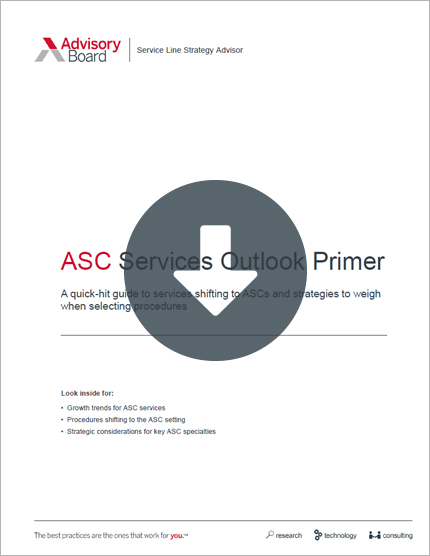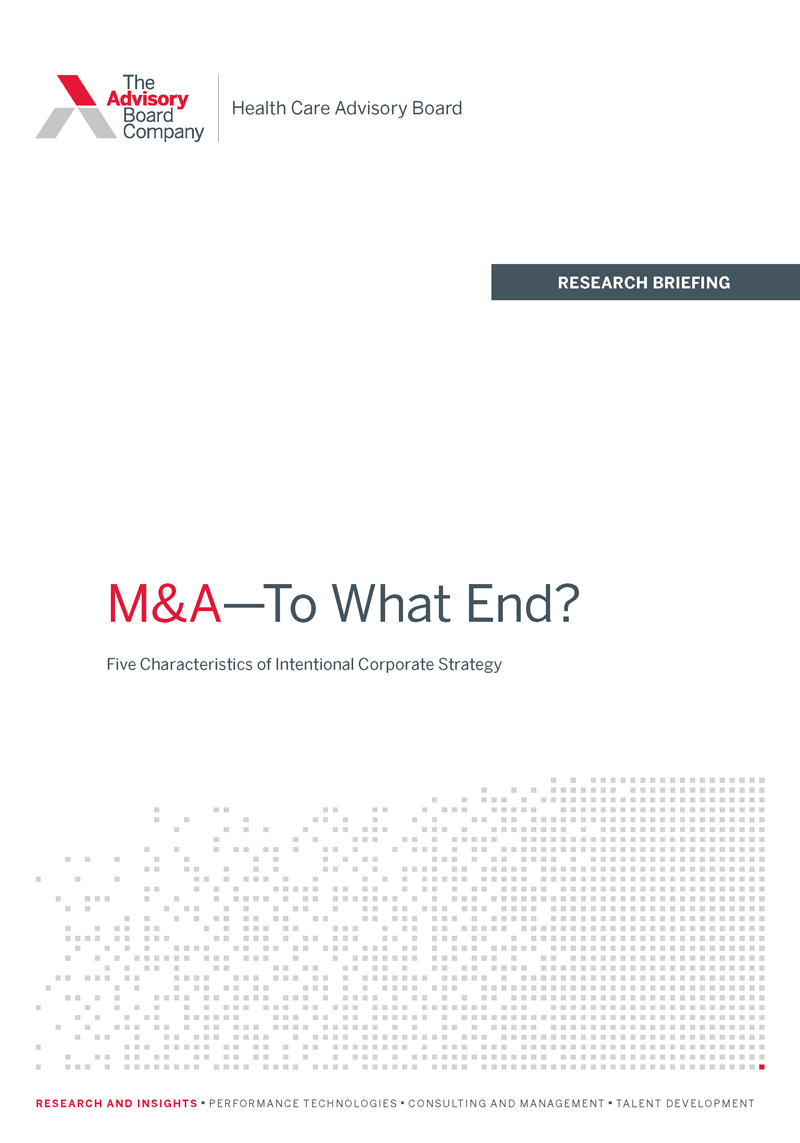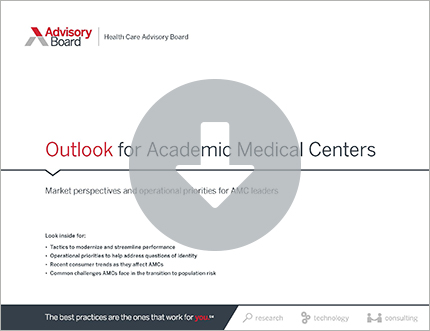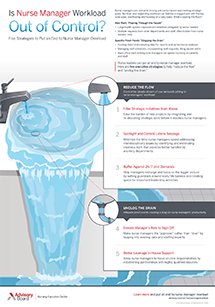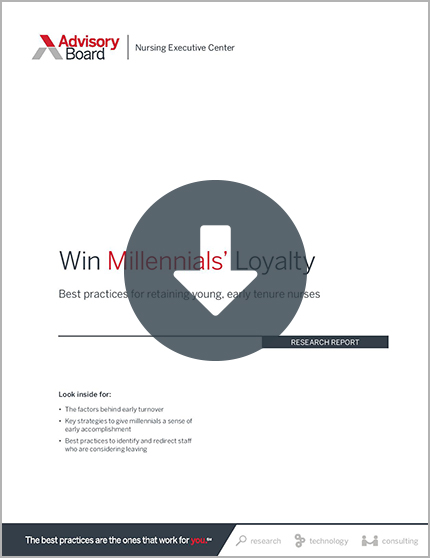Welcome to the "Lessons from the C-suite" series, featuring Managing Partner Eric Larsen's conversations with the most influential leaders in health care.
In this edition, Nancy Howell Agee, president and CEO of Carilion and chair of the American Hospital Association, talks to Eric about the "restlessness" that drove her from the nursing office to the C-suite, how she is guiding Carilion's pivot to value-based care, and how she helped reimagine the medical school curriculum to launch the Virginia Tech Carilion School of Medicine.
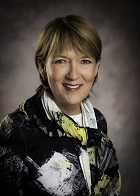
Nancy Howell Agee, president and CEO of Carilion and chair of the American Hospital Association
'We are trying to keep people out of our hospitals'
Question: Nancy, what strikes me most about your work at Carilion is how prescient you and your colleagues were—in advance of many others in our industry, especially academic medical centers—about the shift to population health and the need to self-disrupt our traditional acute-care-centric model. In fact, almost a decade ago you explicitly said, "We are trying to keep people out of our hospitals."
Nancy Howell Agee: Yes, that's right—it has been our focus for a long time. It all goes back to my predecessor, Ed Murphy, who died this past year. He used to say, "We just can't keep doing the same thing. Health care is going to change."
Several years ago, under his leadership, Carilion's four chief officers—including myself—spent about a year investigating who we were and what our communities needed. We developed several possible pathways; in fact, we explored in depth becoming a for-profit organization. But when we went to the board with our options, they were very clear: "You will stay not-for-profit. You will stay headquartered in Roanoke. Management will stay employed by Carilion."
So we went back to the drawing board, and when we examined what was important to us, we realized that the traditional, university-based academic medical center wasn't going to work for us long-term. We needed to zero in on primary care.
Q: What was your framework for building out that model?
Agee: We looked at who did the primary care model well—places like Mayo and Cleveland Clinic—and we visited about 10 of those systems to learn more. We felt like we could adapt that model by building out our primary care network, rather than by necessarily investing in more hospitals. And that was an important distinction, because our plan wasn't focused on getting bigger—it was about providing services in our communities in ways that touched patients.
We focused on developing the clinic, reorganizing physician leadership, and hiring a lot of physicians—about 300 physicians—in a very short period of time. And we're still on this journey.
Q: This "volume to value" journey you're describing, Nancy, has been a turbulent one for many of your CEO counterparts nationally. I'd love your observations on some of the lessons learned that might be applicable to your peers.
Agee: Carilion's board was so supportive and excited when we decided to move into value-based care, and they were steadfast when things got hard. And it did get hard; change of this magnitude is a big deal and gets costly. When our CFO was asked, "What could go wrong?", he said, "Well, the economy could tank, ha-ha"—and sure enough, it did. We went into the red, and we stayed in the red for several years. In fact, one of the things that the board said to me when they asked me if I would be the CEO was, "And you understand that we cannot continue to be in the red?" And I'm like, "I get it."
We spent a lot of money building a replacement hospital, hiring physicians, changing our leadership model, building a whole complex for ambulatory care, constructing a medical school, and implementing Epic enterprise-wide. We also reorganized our primary care into patient-centered homes.
We were basically trying to figure out, "How do you reduce total cost of care, and what does that mean to the health system itself?" Because it might be easier to reduce what happens outside the hospital, with SNFs and urgent-care facilities, but we need to focus on the patient's pocketbook without destroying the health system's financial vitality.
Q: Let's broaden the lens a bit and talk about the acceleration of M&A activity in our industry—not just multi-billion dollar horizontal mergers like Dignity-CHI, but some of the vertical alignments (CVS/Aetna, Cigna/Express Scripts, etc.) that can be 10 times the size. As CEO of Carilion, which—while nearly a $2 billion network—is a comparatively smaller system, do these dynamics change your strategy or calculus at all?
Agee: You know the old saying, "All politics is local?" I think all health care is local, too. If you look at every one of these recent mergers and deals, there's rationality to it. These stakeholders didn't, for the most part, wake up one day and say, "I want to be big." And there are really only a few of these mega-mergers. They're getting a lot of attention, but there's a reason—a different reason—for every one of them. So it's very hard to generalize.
For us, we are mission-driven. Our mission is taking care of about a third of Virginia. That doesn't mean we're not going to get bigger, but we're going do it thoughtfully. And in some ways, historically, our system has been there, done that—we don't have to do that again. If we don't have capital needs, we can continue to pay our bills.
Ultimately, we're interested in collaboration. We don't have to own it all. We have great physicians who happen to get a paycheck from Carilion, we have great physicians who don't, and you wouldn't know who's who. We collaborate beautifully together.
Launching a new medical school
Q: A few minutes ago, you made a passing remark about something that's actually pretty remarkable: You started a new medical school. Tell me how that came about. Was your plan to build a relationship with Virginia Tech from the start?
Agee: No, our relationship with Virginia Tech wasn't originally part of the journey. When those conversations started, I had been responsible for Carilion's medical education for a while—education is another passion of mine—but while we had residents and fellows, we didn't have a medical school.
Then one day, Ed came into my office and just said, "Why don't we do a medical school? How hard could it be?"
Q: Famous last words.
Agee: Exactly—it turns out it can be really hard to do. But serendipitously, at the time, Virginia Tech had a new president who wanted to establish the university as one of the top 30 research universities in the country, and he needed a medical school to reach that goal. We came together and developed a medical school that's a bit different than every other medical school out there: a little smaller, more purpose-built, with a slightly different curriculum, and, like you said, very research-intensive.
Now, think about that: We had no research! What were we thinking? It was another one of those, "How hard can this be? Oh, actually, it can be really hard"-type moments. There we were, building the clinic, and then creating the medical school, and then establishing this research-intensive curriculum, and then—during all of that—we added a research institute. And the research institute started with zero external funding and no researchers. Now, just seven years later, the research institute has $80 million in external funding, and it's already out of space; we've just broken ground on doubling its size.
So there were some hard moments, but I'm incredibly proud of all of it. It worked out beautifully.
Q: Let's talk about the evolution of that curriculum. I think we'd agree that most medical schools have been slow to change; it is only a slight exaggeration to say the curriculum of many is still based on the century-old Flexner Report. But Carilion and Virginia Tech created the school de novo, and there was a lot of originality in how you constructed the curriculum.
Agee: Yes, that's exactly right. When we developed the curriculum for the medical school, the original intent was for it to be a five-year school, with an extra year to get an MPH or an additional master's degree. But the dean who we hired immediately said it was a bad idea. Instead, we ended up developing a problem-based curriculum, and then we built the school around that. Not a lot of places do that; it's almost self-taught. Students are grouped into teams, and the teams work on problems, studying a case from the beginning—you actually get to see a patient in your first year.
Q: And Carilion also has a unique application process as well: You invite the community to be part of the interview process.
Agee:This is actually a really cool part of our program. After applicants get through the usual GPA, MCAT, how-great-you-are process, they actually have to sit down for an interview with members of the public. We invite people—just normal people, not doctors—to come in to be the interviewers. They'll sit down on a Saturday, and half the day will be these interviews with prospective students and the other half a day will be spent touring the region with the prospective students. It's really engaged the community, so the students are building a strong relationship from the start.
We have, say, eight questions on ethics. So one question might be, "OK, there's been a disaster. Only seven people are alive in the world: a 42-year-old school teacher, a 62-year-old professor, a 27-year-old pole dancer, and so forth. Who would you pick to start the world over again?"
There's no right or wrong answer. It's about how the student thinks about the scenario. I used to love doing these interviews, but I don't like to do it anymore because I get my favorite students and then, if they don't get selected, I'm hurt.
Q: And the school has been very intentional about maintaining a small class size, so that can't make it any easier.
Agee: Yes, we made it a small school—just 42 students a year—because all of us who went through health care went to a university where we stood in line to see a patient. There was the fellow, the resident, PGY1, PGY2, PGY3, and so on. We didn't want that for our students.
We'll probably grow the school at some point, but when we do, we'll do it intentionally, with a lot of fidelity to the patient experience and the student experience. It's not about having the biggest school or getting the most tuition. It's, "How can we do this thoughtfully for the students and for our patients and our staff?"
As it is, we're the most competitive school in the country. In 2017, we had about 4,700 applicants for 42 spots. And our classes have just aced USMLE 1, and Step 1 and Step 2, and we've got 100% match so far.
A nurse's perspective on the C-suite
Q: Let's take a step back and talk about your career trajectory, Nancy. You came to the corner office from the nursing ranks, part of a small vanguard of current CEOs to come from nursing (Chuck Stokes of Memorial Hermann is another who comes to mind). What drew you to the profession in the first place?
Agee: As a teenager, I had a bone tumor and had five surgeries and was hospitalized at Roanoke Hospital—which later became Carilion.
That was a scary time for me, but I really just felt this affinity for the nurses because they cared about me as a person. I wanted to be like them, and ultimately that led me to a career as a surgical nurse at Carilion.
Q: And you were born at Carilion too, right? So essentially you've spent a whole lifetime there. What ultimately spurred your shift from that caregiver role to the administrative side of care delivery?
Agee: One day, I had a patient who underwent surgery for cancer. She worked for the American Cancer Society, and she nominated me as Miss Hope. I wound up winning, so I traveled around the state talking about cancer and nursing care. That spurred my interest in cancer care, and I wrote a white paper on why hospitals needed to do more for cancer patients. I shared it with our administration, and a few weeks later they called me up and said, "We think this actually makes sense. Would you like to do it?"
I essentially became a care coordinator, in today's vernacular. I was an internal resource for the nursing staff for patients with cancer. My one stipulation to them was that I wouldn't take cases with kids. On that same day, I was walking out of the nursing office and the director called me over and said, "Pediatrics called and they have a cancer patient that they don't know what to do with." I responded, "That's not my specialty. I don't know how to do that." And they said, "Well, if you don't, and if you don't know what to do, nobody does. You'd better go." This was a three-year-old with a rhabdomyosarcoma. It was at that moment that I realized I could help that family and the staff, so I dove in.
But after doing that job for a while, I realized that I needed more education and experience to do it right. I went back to school—and while I was there, I found out about an NIH grant for an oncology cancer program.
So I decided to write a grant proposal, and we won it, and I became the director of the grant. It involved all four hospitals in Roanoke and aimed to coordinate cancer care for the whole region. So I got to spend about three and a half years working with folks from all across the region to create hospice and oncology programs. That was a huge opportunity, and I'm so grateful for it.
Q: You worked your way up from that role to holding multiple positions in the C-suite—COO and EVP—before become CEO. How did you navigate all of these career shifts? Did you have a preconceived idea of what you wanted to do, or was it a gradual realization?
Agee: It was two parts: One was this sort of restlessness—you know, who was I to be a staff nurse writing a white paper, writing up an NIH grant?—but also a certain sense of opportunism. I think a lot of nurses have great ideas. They get frustrated with how things are, but for some reason it doesn't translate to action. That never stopped me.
Mentorship of nurses
Q: I'm interested in your perspective on this issue, Nancy—how you can catalyze nurses to take action—particularly given your nursing background. Is acting decisively on that "call to action" something that you counsel nurses to do when they seek professional guidance from you?
Agee: I try to be thoughtful and understanding about what people need—but then I encourage them to do something about their concern. "What are we going to do about it?"
That "we" is important. It's not, "What are you going do about it?", because that's just pointing fingers. When you ask, "What can we do about this?", there's a level of empathy there, an effort to understand how we can make things better together.
Q: More broadly speaking, for too long, there has been a scarcity of women system CEOs, and that imbalance is now being righted. I imagine in your position—both as Carilion CEO and AHA Board Chair—young professional women seek your counsel on which professional experiences and roles to seek out intentionally. How do you counsel young professional women on advancing their careers?
Agee: To borrow somebody else's language: Lean in, get busy, don't say "no." It's not that I'm not respectful of work-life balance—I am! —but part of my balance is getting excited about what I do. If you really are interested in advancing, you have to put yourself forward and get outside yourself.
And that's really how I shaped my own career, with the American Cancer Society—where I served on the Board—and other places where I could volunteer my time, like the Mill Mountain Theater. I don't know anything about theater, and I'm not an actress, but it was a great way to meet people different from me and to get Board experience. In fact, I think I learned a lot more about business in these different arenas than I would have gotten if I just focused on health care.
I don't know anything about theater, and I'm not an actress, but it was a great way to meet people different from me and to get board experience. In fact, I think I learned a lot more about business in these different arenas than I would have gotten if I just focused on health care.
Ultimately, though, my advice is to follow your passion. Be authentic. Be true to yourself, because if you try to do something that's different, you're just going wear out. It's not going be who you are.
Role as AHA chair
Q: Before we wrap up, I'd like to talk a bit more directly about your work with AHA. How are you thinking about your new role? What are your priorities as chair?
Agee: I think that the most important thing I can do for AHA is what I do for Carilion: I'm the cheerleader; I tell our story. In AHA, we're all in this together. It doesn't matter what your politics are, or how you articulate what you're doing, or what you're strategically considering. At the end of the day, it's about doing the right thing for the communities we serve.
So, as chair-elect and now as chair, my role really comes down to learning, listening, and sharing that message in various ways: social media, interviews, lots of talking. For instance, AHA lets the chair-elect choose an area of emphasis, and then we get to integrate that across the organization. For me, that focus was on affordability, value, and care. We were really looking at those issues, and it eventually morphed into the value initiative, which now has its own website.
Q: Why did you single that out as your area of focus, given the broader, industry-wide work to address those issues?
Agee: Three years ago, that focus area may have seemed a little like, "Duh, that's the place we're all moving to." But now we have the Trump administration, which has been a little confusing, and a lot of industry stakeholders—hospitals, insurers, and pharma—are taking different approaches toward value-based care. We're still not all pulling in the same direction.
Even just a focus on quality is difficult. We measure too many things, and we don't have clear definitions—or even the same definitions. There aren't any standardized benchmarks. So that's another part of the value question that gets a lot of attention but not much progress, and I view my role as working to address that.
Gratitude
Q: You and I have known each other for a long time, Nancy, and I've long admired how you cultivate a balance in your life. And in your role, balance is one of the most elusive things to capture. Any insights or advice for others as they seek that slippery equilibrium between work and 'life?'
Agee: When I was a hospice nurse, I remember a cocktail party where everybody was talking about crap—literally. My first reaction was to think, "Oh, my God. These are inane conversations, and I've got people over here whose lives are ending."
But at that moment, I realized that this is life. Not everybody's dying. We can have fun. We can enjoy time. We can also have joy. And that's OK. In fact, in some ways, exercising that attitude also helps people who are dying, because we can share that enjoyment of life with them.
Q: Just one more question in closing: What are you most grateful for as you look back over your career?
Agee: The opportunity. It's been an almost sacred journey. Being able to share this experience who do this work every day is just amazing; being able to make a difference in the lives of our patients is amazing; living in the community where we get to see, every day, the work we've done—that's amazing.
I mean, I remember the flood of '85. My father died that night, and I remember looking out my window at a floodplain and the brown space and seeing just nothing there. It was a region that was beginning to feel as if we weren't going to be any better than we were.
But now, this is a thriving medical community that's been a catalyst for change for the whole region, that's made people feel like, "We're somebody, and we're going be OK, and we're going to make a difference."
People often ask me, "What's it going to be like in 10 years?" I could not have predicted 10 ago that we'd be where are now, but I can tell you that we're going to be even better 10 years from now. And to know that it gets better? That's pretty incredible.
Questions or comments about Lessons from the C-suite? Email Eric at larsene@advisory.com.
Get more lessons from the C-suite
Check out Eric's recent must-read interviews with top hospital and health system leaders:
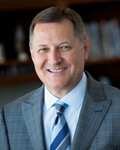 How a 'God moment' put Terry Shaw on a 35-year path to CEO—all at Adventist Health System
How a 'God moment' put Terry Shaw on a 35-year path to CEO—all at Adventist Health System
Terry Shaw, president and CEO of Adventist Health System, talks about Adventist's approach to spiritual care, why he thinks about growth "like a farmer," and how he plans to turn AHS into a $20 billion system. Read our interview with Terry.
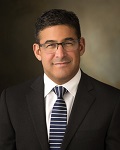 Marc Harrison promised to turn Intermountain into a 'Tesla.' He wasn't kidding.
Marc Harrison promised to turn Intermountain into a 'Tesla.' He wasn't kidding.
Marc Harrison, president and CEO of Intermountain Healthcare, talks about Intermountain's recently announced strategic reorganization, previews the launch of a "virtual hospital" to better serve rural communities, and shares the surprising worry that keeps him up at night. Read our interview with Marc.
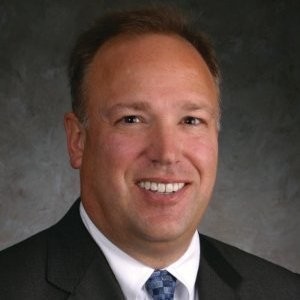 'Why not us?': How Kevin Vermeer seeks to disrupt health care from the helm of UnityPoint Health
'Why not us?': How Kevin Vermeer seeks to disrupt health care from the helm of UnityPoint Health
Kevin Vermeer, president and CEO of UnityPoint Health, talks about his Dabo Swinney-inspired approach toward recruitment, going "all in" on value-based care, and how "gratitude journals" are reshaping the culture of UnityPoint Health. Read our interview with Kevin.
Don't miss out on the latest Advisory Board insights
Create your free account to access 2 resources each month, including the latest research and webinars.
Want access without creating an account?
You have 2 free members-only resources remaining this month remaining this month.
1 free members-only resources remaining this month
1 free members-only resources remaining this month
You've reached your limit of free monthly insights
Become a member to access all of Advisory Board's resources, events, and experts
Never miss out on the latest innovative health care content tailored to you.
Benefits include:
You've reached your limit of free monthly insights

